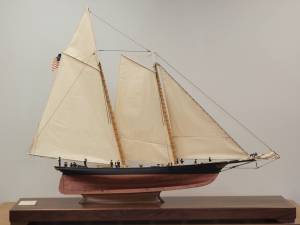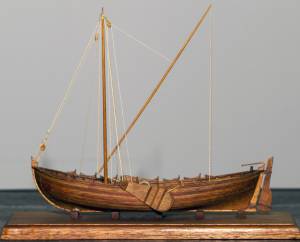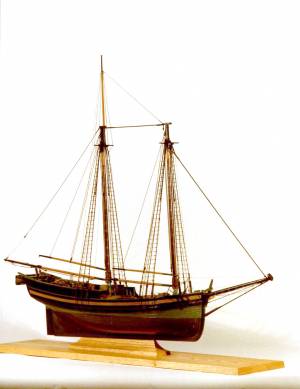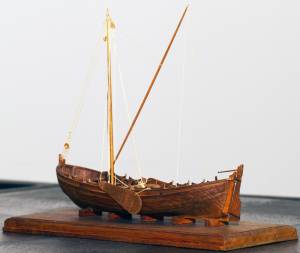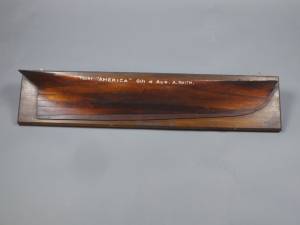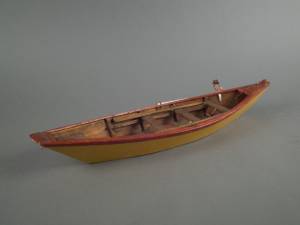An online project under the direction of the CAPE ANN MUSEUM
Ship Models
Ship models as aids in the design of a ship played an important role in America from the late eighteenth century to the early twentieth. Most widespread was the builder's half-model, a half hull to scale, such as 1/2" = 1' (1:24 or one twenty-fourth actual size). These half-models were made in three ways: block half-hulls, "hawk's nest" models, and "lift" half models.
The block half-hull was the simplest—the shape of one side of the hull was carved from a solid piece of wood. "Stations," locations of frames at convenient intervals, were marked on the hull and "templates" wooden shims carefully shaped to fit closely at each station were made from thin sheets of wood. The templates could then be traced on paper (or wood, if paper was too expensive) marked with a grid for measuring dimensions at regular intervals. The paper grid was redrawn on a mold loft floor to the full size of the vessel, and measurements were made where the grid lines intersected the traced curves. Wooden patterns called "molds" were made from the measurements and used as patterns for full-size frames.
The "hawk's nest" model consisted of solid "frames" (actual molds), mounted on a "back board," and fitted with a keel, stem, stern post, and thin strips of wood outlining the run of the hull planking. More importantly, the strips, or "stringers," aided in the "fairing" of the frames so planks would fit to the frames without showing bumps or hollows.
The "lift" half model was the method of choice from the 1840s onward. Carefully planed boards of uniform thickness were screwed together and carved to the shape of the envisioned half-hull. After the desired hull form was established, the surface was carefully smoothed and "faired", aided by flexible battens and "sighting" the curved surfaces. The model was then disassembled and each lift traced, taking care that the lifts were accurately superimposed on the tracing sheet. The hull profile was also traced, usually in alignment with the lift tracings. The locations of frames (or sometimes only every second or fourth frame) were carefully drawn on the tracings and their "half breadths" measured and tabulated. When the half-breadths were converted to full size dimensions, they became "offsets" used to lay down the molds for the frames. Sometimes, the offsets were written on station lines scribed on the top surface of each lift, making the model its own table of offsets.
Builders' half models are priceless documents of nineteenth-century ship design and have been the essential starting point for many important reconstructions of the vessels of that period, whether in model or full-size reconstruction. They rank among the most important objects in marine museum collections.
– Erik Ronnberg
Reference:
Howard I. Chapelle, The National Watercraft Collection (Washington, DC: Smithsonian Institution, 1962).
Wood, metal, cordage, Egyptian cotton sail cloth
Scale: 3/8" = 1'
Private collection
Plaque reads: "Schooner Yacht America. Designed by George Steers and built by William H. Brown at New York City, 1851 Winner of the Royal Yacht Squadron £100 Cup in a race around the Isle of Wight, August 22, 1851."
Also filed under: "America" (Schooner Yacht) »
Also filed under: New England Boat / Shallop (ancestral type) »
Also filed under: Chebacco Boat / Dogbody / Pinky »
Model made for marine artist Thomas M. Hoyne
scale: 3/8" = 1'
Thomas M. Hoyne Collection, Mystic Seaport, Conn.
While this model was built to represent a typical Marblehead fishing schooner of the early nineteenth century, it has the basic characteristics of other banks fishing schooners of that region and period: a sharper bow below the waterline and a generally more sea-kindly hull form, a high quarter deck, and a yawl-boat on stern davits.
The simple schooner rig could be fitted with a fore topmast and square topsail for making winter trading voyages to the West Indies. The yawl boat was often put ashore and a "moses boat" shipped on the stern davits for bringing barrels of rum and molasses from a beach to the schooner.
– Erik Ronnberg
References:
Jeffrey Bolster, Black Jacks: African American Seafarers in the Age of Sail (Cambridge, MA: Harvard University Press, 1997).
Howard I. Chapelle, American Small Sailing Craft (New York: W.W. Norton & Co., 1951), 29–31.
Also filed under: Hand-lining » // Schooner (Fishing) »
Wood, metal, cordage, cloth, paint.
Scale: ¼ in. = 1ft. (1:48)
Cape Ann Museum. Gift of Roland and Martta Blanchet (1997.17.3)
Although built in 1890 and larger than the stone sloops of Lane’s time, the "Albert Baldwin’s" hull form, rig, and loading boom are very similar to those of the 1840s and 1850s.
Also filed under: Granite Quarrying / Shipping » // Sloop »
Cape Ann Museum Library & Archive
Diorama of Gloucester fishing boats, which includes several models now in the collection of the Cape Ann Museum
Also filed under: Fishing » // Historic Photographs »
Also filed under: Chebacco Boat / Dogbody / Pinky »
Also filed under: New England Boat / Shallop (ancestral type) »
Mahogany, cotton, paper, metal
29 x 34 x 6 1/2 in (73.66 x 86.36 x 16.51 cm)
M27746
Peabody Essex Museum
Also filed under: Schooner (Pilot) »
Wood
New York
35 1/2 x 37 x 5 1/2 in. (90.17 x 93.98 x 13.97 cm)
Peabody Essex Museum
Also filed under: "America" (Schooner Yacht) »
Gloucester, MA
4 x 33 1/2 x 7 1/4 in (10.16 x 85.09 x 18.415 cm)
Peabody Essex Museum
Also filed under: Objects » // Small Craft – Wherries, and Dories »
Also filed under: Chebacco Boat / Dogbody / Pinky » // Small Craft – Wherries, and Dories »
wood, metal, cordage
Model of schooner yacht "Northern Light" of Boston, 1839
Scale 1:32
Also filed under: "Northern Light" (Yacht) » // Yacht & Small Pleasure Craft »
20" l. x 19" h. x 3 3/4" w. [not to scale]
Cape Ann Museum. Gift of Mr. J. Hollis Griffin, 1940 (891)
"Pinkys" were early nineteenth-century schooner-rigged derivations of Chebacco boats. This model is a good example of a traditional “sailor’s model,” or in this case, a sailmaker’s model, Mr. Nickerson having been a sailmaker.
Also filed under: Chebacco Boat / Dogbody / Pinky »
